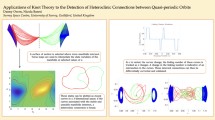Abstract
Interval identification systems is a notion that, on the one hand, generalizes interval exchange transformations and, on the other hand, describes special cases of such transformations. In the present paper we overview some elementary facts, address a few questions about interval identification systems, and describe explicitly systems that allow one to construct 3-periodic surfaces in the 3-space whose intersections with planes of a fixed direction have chaotic behavior. The problem of asymptotic behavior of plane sections of 3-periodic surfaces was posed by S.P. Novikov in 1982 and studied then by his students. One of the most interesting remaining open questions about such sections is reduced to the study of interval identification systems.
Similar content being viewed by others
References
M. Keane, “Interval Exchange Transformations,” Math. Z. 141, 25–31 (1975).
W. A. Veech, “Gauss Measures for Transformations on the Space of Interval Exchange Maps,” Ann. Math., Ser. 2, 115(1), 201–242 (1982).
H. Masur, “Interval Exchange Transformations and Measured Foliations,” Ann. Math., Ser. 2, 115(1), 169–200 (1982).
J. Hubbard and H. Masur, “Quadratic Differentials and Foliations,” Acta Math. 142(3–4), 221–274 (1979).
I. Agol, J. Hass, and W. Thurston, “The Computational Complexity of Knot Genus and Spanning Area,” Trans. Am. Math. Soc. 358(9), 3821–3850 (2006).
I. Dynnikov and B. Wiest, “On the Complexity of Braids,” J. Eur. Math. Soc. 9(4), 801–840 (2007).
S. P. Novikov, “The Hamiltonian Formalism and a Many-valued Analogue of Morse Theory,” Usp. Mat. Nauk 37(5), 3–49 (1982) [Russ. Math. Surv. 37 (5), 1–56 (1982)].
A. Ya. Maltsev and S. P. Novikov, “Dynamical Systems, Topology, and Conductivity in Normal Metals,” J. Stat. Phys. 115, 31–46 (2003); arXiv: cond-mat/0312708.
A. V. Zorich, “A Problem of Novikov on the Semiclassical Motion of an Electron in a Uniform Almost Rational Magnetic Field,” Usp. Mat. Nauk 39(5), 235–236 (1984) [Russ. Math. Surv. 39 (5), 287–288 (1984)].
I. A. Dynnikov, “Semiclassical Motion of the Electron. A Proof of the Novikov Conjecture in General Position and Counterexamples,” in Solitons, Geometry, and Topology: On the Crossroad (Am. Math. Soc., Providence, RI, 1997), AMS Transl., Ser. 2, 179, pp. 45–73.
I. A. Dynnikov, “The Geometry of Stability Regions in Novikov’s Problem on the Semiclassical Motion of an Electron,” Usp. Mat. Nauk 54(1), 21–60 (1999) [Russ. Math. Surv. 54, 21–59 (1999)].
G. Rauzy, “Echanges d’intervalles et transformations induites,” Acta Arith. 34, 315–328 (1979).
R. De Leo and I. A. Dynnikov, “Geometry of Plane Sections of the Infinite Regular Skew Polyhedron {4, 6 | 4},” arXiv: 0804.1668.
Author information
Authors and Affiliations
Additional information
Published in Russian in Trudy Matematicheskogo Instituta imeni V.A. Steklova, 2008, Vol. 263, pp. 72–84.
To S.P. Novikov on the occasion of his 70th birthday
Rights and permissions
About this article
Cite this article
Dynnikov, I.A. Interval identification systems and plane sections of 3-periodic surfaces. Proc. Steklov Inst. Math. 263, 65–77 (2008). https://doi.org/10.1134/S0081543808040068
Received:
Published:
Issue Date:
DOI: https://doi.org/10.1134/S0081543808040068




